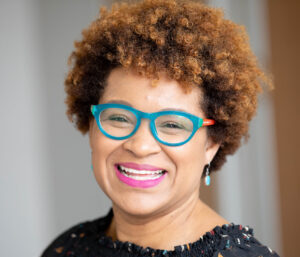‘We’re all on this journey together’: Bringing everyone together for DE&I
Director of Diversity, Equity, and Inclusion and Culture at the University of California’s Department of Anesthesia and Perioperative Care shares how she makes room for others.

Leah Pimentel, inaugural director of Diversity, Equity, and Inclusion and Culture at the University of California’s Department of Anesthesia and Perioperative Care, wants her colleagues to know that they are seen and their opinions are deeply valued at work.
Pimentel oversees the department’s DE&I committee of six members. She also serves on the San Francisco Human Rights Commission and works to promote city-wide equity.
In increasingly divisive times, Pimentel ensures that everyone has a seat at the table in the organization and their voices are heard.
Pimentel makes sure employees feel valued in other ways too. She recently created an appreciation gift-giving practice for new employees to set the right tone at work.
Pimentel spoke with Ragan about how she makes impactful organizational changes.
Responses were lightly edited for clarity.
From a communication standpoint, how do you effectively convey innovative ideas and solutions to your team and stakeholders?
When I first started, I said, ‘We’re all on this journey together. And we’re all coming from different places. And that’s okay.’ But I think the first thing is to clearly articulate your vision and in DEI it’s not a one-month plan, not a 36-month plan. It’s actually a lifelong journey of understanding, education, self-reflections. … Also creating a supportive environment. … One person cannot do this all. So how can we all work together? Everyone has great ideas, they want to participate. Okay, let’s bring that to the table.
How do you strategically use your influence for work culture change as a purpose-driven leader on the job?
Really defining and articulating that clear purpose of what am I trying to do … and empowering others on the team to be the leader. So, for the DEI and culture team, I ask them what do (they) want to do. What do (they) want to see? … How do you want to educate the department? And giving them that empowerment to be involved because … we’re all (in the) anesthesia (department). And changing that branding and wording and separation to we’re all one team and empowering each other to work together in decision-making and (getting) feedback as well. And leading by example is most important.
Can you explain your onboarding gift process and how you came up with that idea?
One thing I thought about is it’s your first day, you’re excited! You’re that new employee – it’s a fresh start. How can we show you our brand, our culture and make you feel welcome? This is one of my first ideas. … It’s for them to understand the company culture. We are a department that values our employees. We want you to stay. We want to provide you with education, tools and resources as well. By receiving this gift, you see our brand … So, the swag has a box with our logo on it and you open it up and there is a little note that says, ‘We appreciate you and thank you for being part of our team.’ There’s a personalized department water bottle, socks, Chapstick, sunglasses, a notepad and a pen.
How do you integrate Maslow’s Hierarchy of Needs into an organizational culture and help employees feel safe, especially through a DE&I lens?
I think that it is particularly important … to ensure psychological and basic safety needs are met. That we have fair wages and benefits and safe working conditions and a supportive work environment … To ensure that we have belongingness and we promote inclusivity and foster a sense of community, encourage teamwork, collaboration and open communication.
How can workplace leaders better understand the important role they play in creating an engaging, fulfilling and productive atmosphere at work?
Feedback and data (are) important. So, one thing that we do is we have to understand what events do people like to go to. So, we have a variety of morale events. … Our staff DEI and culture team, they’re working on a survey to ask the department what is your level of understanding of DEI, but also how will you want to learn about things. I think it’s important to meet people where they are and teach (them) how (they) want to be taught.
What tips would you give to others looking to integrate DE&I into their department through allyship and accountability?
Take the initiative and educate yourself about diversity, equity and inclusion. Read books, articles and resources and explore different perspectives and experiences because … you want to be well-equipped to foster and create a more inclusive, equitable workplace that constantly changes in a DEI world – and having a pulse on what’s currently happening. I would also say reflect on bias.
What are your go-to strategies for building an employer brand that can withstand societal pressures while remaining true to its purpose and values?
(Start) with a clear definition of our organization’s purpose and our core values and then articulating them in a meaningful and specific way to ensure they align with the aspirations and beliefs of the department and our target audience. Conducting an audit to assess what is the current culture, policies and practices and understanding the potential alignment and areas for improvement.
As a leader on the Human Rights Commission, how do you bring that advocacy for racial solidarity, equity and healing in San Francisco to your DE&I work?
One of the important and critical things to do is (understand what) is the best approach to help and tailor DEI efforts accordingly. And collaborating with community stakeholders because oftentimes the community has a breadth of knowledge of what’s going on in San Francisco as well. And they are your partners in how you can build partnerships with the stakeholders to ensure DEI initiatives are community-centered and respond to their local needs. … Making racial justice and equality at the center of diversity work. … Seeing what’s happening on the Human Rights Commission and the work we do is very much connected to that DEI work. How are we being an ally and helping various communities?
Learn more about DEI in the workplace and other relevant topics by joining us at Ragan’s Employee Communications & Culture Conference on April 16-18 in Chicago.
Sherri Kolade is a writer and conference producer at Ragan Communications. She enjoys watching old films, reading and building an authentically curated life. Follow her on LinkedIn. Have a great PR/comms speaker in mind for one of Ragan’s events? Email her at sherrik@ragan.com.







